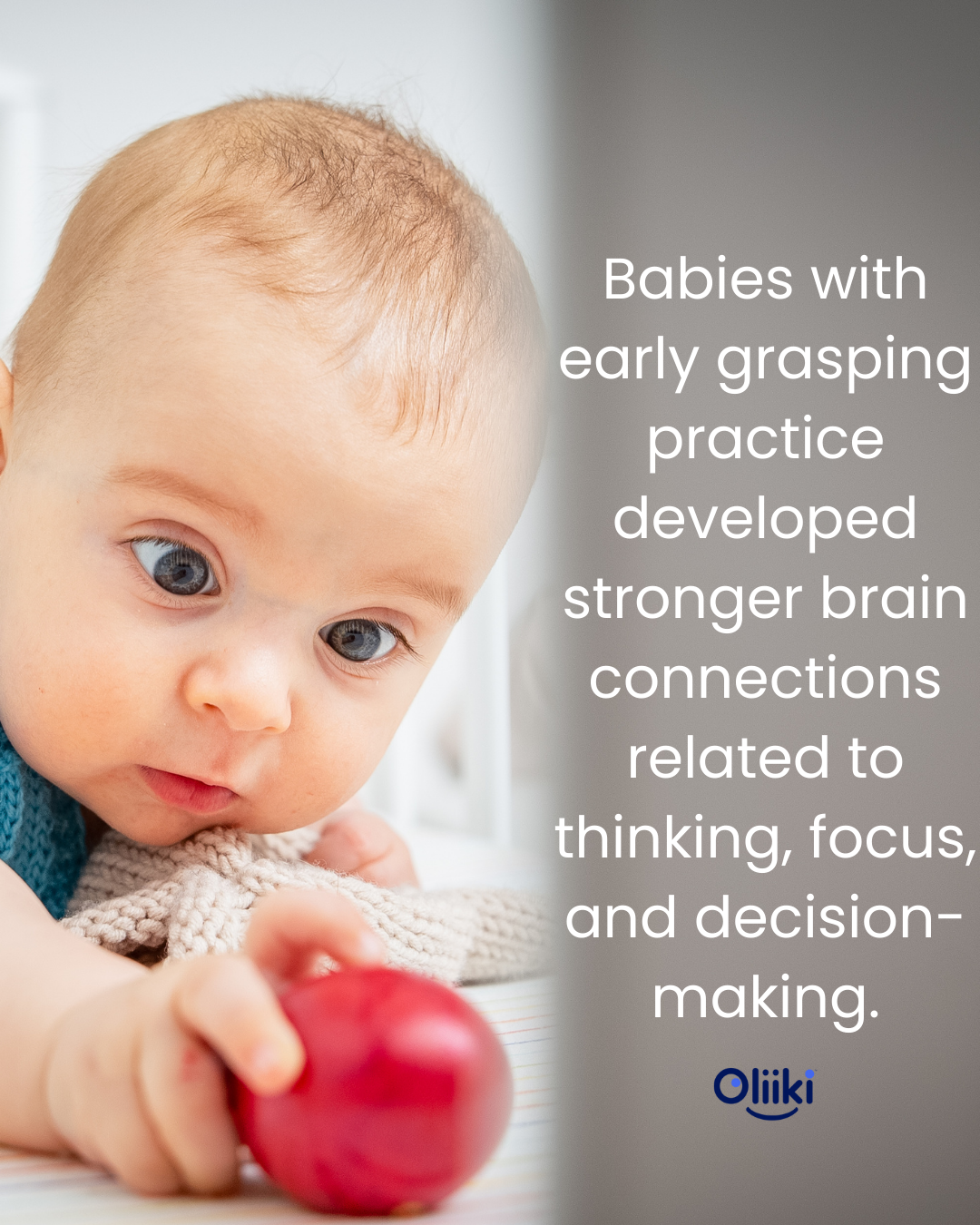Why Your Baby’s First Grasps Help Their Brain Development
Until recently, I’d not given reaching and grasping a thought! But I bet as you read this you’re either grasping a phone or holding a mouse. You might have a cup in hand with the all-important cuppa and I bet you’ve reached out and grasped hundreds of things today. For your baby, this is a skill that needs learnt, built up through thousands of tiny experiences, tests and repetitions.
Why Does Early Grasping Matter?
Reaching and grasping are among the first ways your baby interacts with the world. From clenching their tiny fingers around, yours to reaching for a dangling toy. These movements are so small we don’t really notice them at all. They seem so simple, so incidental and in the beginning so uncoordinated, but they actually play a crucial role in a baby’s overall development and impact their future life learning in more ways than you might think! So how exactly does something as basic as grasping shape cognitive growth? Let’s explore the science behind early grasping and why these motor skills are essential for lifelong learning.
The Key Takeaway
Grasping isn’t just about holding objects it’s actually an important step in brain development. When babies reach, grab, and manipulate objects, they are strengthening neural connections (brain connections) that support problem-solving, hand-eye coordination, and even future academic skills like writing, reading, and spatial reasoning. Amazingly, encouraging these movements early on can significantly impact cognitive development later on.
The Science of Grasping: How the Brain Develops Through Touch
Grasping is more complex than it first seems. In order to be able to grasp, the brain needs to combine input from the senses with movement to create coordinated actions. This is known as a sensorimotor skill, and grasping is one of the first!
When your baby was born they may well have grasped your fingers and you might have been surprised by their strength and determination to hold on. This is the palmar reflex in action. The palmer grasp is an automatic reflex but over time, this reflex gives way to purposeful grasping, which is driven by your baby’s brain maturating through the experiences you have offered them.
Connecting sensory experiences with movement is the foundation for problem-solving, spatial awareness, and even memory formation. And researchers found that babies who had more frequent opportunities to practice grasping earlier than expected developed stronger brain connections in the prefrontal cortex—the area responsible for thinking, focus, and decision-making.
Isn’t that bonkers?! Who’d have thought babies could gain so much from the simple act of reaching out for something and grasping it!
So why does Grasping help so much?
Why Grasping Supports Your Babies Future Learning
Every time a baby reaches for and holds an object, they strengthen critical pathways in the brain that support:
Hand-eye coordination, is vital for writing, playing sports, and using tools in the future. That future pilot you are nurturing, will be using the skills he honed in the first few months of life to fly his plane! - is your mind blown yet?!
Problem-solving - as babies play, they experiment with different ways to hold and manipulate objects, this knowledge helps them lay the groundwork for logical thinking.
Memory and learning, your baby knows they saw their toy over there, all they have to do is remember where it is and coordinate their body, arm head and hand and then they can get it. These repetitive actions help babies store and retrieve information, strengthening neural pathways for future academic skills and helping them build bigger, better brains!
Language development - Research suggests a strong link between fine motor skills and early vocabulary growth because all those new objects bring babies in contact with new vocabulary. As babies mature, they actively use non verbal communication to signal what they want, these signals are the precursors of language development.
Practical Ways to Encourage Grasping and Cognitive Growth
I know, it’s bonkers isn’t it, that this simple act of reaching out and grasping is so massive for our babies. Who would have thought?!
Now we know all this I am sure you are desperate to get going with some! So, what can you do?
Here are some practical, research-backed activities to help give your babies the opportunity to reach out and grasp from infancy:
For Parents:
Finger Play – Start this one with your newborn. Offer a finger for your baby to grasp to encourage their natural palmar reflex. (Don’t forget to grab a picture of it too, because it’s so cute!)
Tummy Time with Toys – Yup, it’s tummy time again (it’s SOOOOOOO important) Place textured, lightweight toys just out of reach it will help motivate your baby to stretch out and reach.
Object Exploration – Let your baby explore soft, varied-textured objects are perfect for an easy grasp and they are fabulous to explore.
Hand-to-Hand Transfers - watch for this one developing. It happens around 4-6 months. Once it starts coming, encourage your baby to pass objects from one hand to another. It’s a tricky thing but it improves their, improving bilateral coordination which is the ability to use both sides of the body together in a controlled and organised way.
Songs and Action Rhymes – You know I love songs and action rhymes for so many things, and one of those is to enable babies to use their hands in a coordinated way to the rhythm of the song. ‘Twinkle, Twinkle’ is perfect for this!
For Nurseries and Early Years Educators:
Sensory Baskets pop these out full of lots of different safe, age-appropriate objects for your babies to explore. Be sure to think about the different textures, weights and hand grips needed to hold them
Hanging Mobiles and Ribbons are brilliant for encouraging reaching and grabbing. Position mobiles within reach to encourage reaching and tracking movements. With your younger children put them to the side as their peripheral vision is better than any other kind in the early days.
Texture Play is so much fun and there are so many textures to explore! Provide materials like crinkly fabric, wooden blocks, or soft sponges for varied sensory feedback.
Small Group Exploration, yes other babies are also fascinating and offer masses of sensory feedback! Allow babies to interact with peers, observing and mimicking each other. They will mirror others behaviours and learn more about reaching and grasping from them.
And don’t forget to go outside! There’s so much learning opportunity out there. Nature is a brilliant teacher.
All of these activities support the Early Years Foundation Stage (EYFS) framework, particularly in the areas of Physical Development, Communication & Language, and Personal, Social & Emotional Development.
What If My Baby Is Struggling to Grasp?
Some babies take longer to develop their grasping skills, and that’s okay. If that’s your baby, you can help them along the way. If your baby isn’t reaching for objects by 5-6 months, try these strategies:
Provide visually stimulating toys to encourage them to focus.
Use soft rattles to add sound motivation and because they are soft, they are easier to grab.
Offer hand-over-hand assistance, pop your hand over their hand and gently guide their grasp.
Spend timedoing more skin-to-skin contact, as this enhances sensory-motor integration (in other words, it improves the ability of the brain to process information from the senses and translate it into coordinated movement actions .
If you are worried, chat to your doctor or talk to your early years’ practitioners at child care or talk to a a paediatric physiotherapist and they will give you some additional suggestions.
It’s The Tiny Movement That Matter
The amazing thing about baby development is it’s the tiny, everyday actions that make huge impacts on your baby’s development. Seemingly simple things like reaching for a toy have a massive impact on their life outcomes. And it’s not just reaching and grasping that are this huge for your baby, there are so many things that help them develop and the best way to do that is through the tiny playful moments you share every day! Knowing what to do and how those things help your baby’s development is the hard bit.
That’s why the Oliiki app is here to help you from the first day of conception right through until your baby is two. The Oliiki app is used in nurseries up to support baby development. If you’re a nursery and you’d like to find out how you can become an Oliiki nursery go here. If you’re a parent, it’s here for the Oliiki app and here for more information about how you can help your baby reach their full potential and thrive through tiny playful moments. .
Want More Support?
🔹 Try the Oliiki Baby Brain Building App for free for the first 7 days for simple, research-backed grasping activities you can do at home.
🔹 Nurseries: Explore Oliiki’s training resources to enhance your early years settings.
🔹 Follow Oliiki on Instagram and TikTok for more early years insights!




